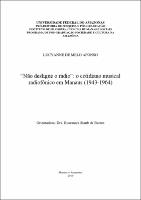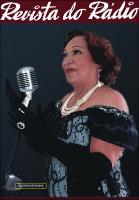| ???jsp.display-item.social.title??? |


|
Please use this identifier to cite or link to this item:
https://tede.ufam.edu.br/handle/tede/7336| ???metadata.dc.type???: | Tese |
| Title: | "Não desligue o rádio": o cotidiano musical radiofônico em Manaus (1943-1964) |
| ???metadata.dc.creator???: | Afonso, Lucyanne de Melo  |
| ???metadata.dc.contributor.advisor1???: | Barros, Rosemara Staub de |
| ???metadata.dc.contributor.referee1???: | Barbosa, Walmir de Albuquerque |
| ???metadata.dc.contributor.referee2???: | Costa, Antonio Maurício Dias da |
| ???metadata.dc.contributor.referee3???: | Mesquita, Otoni Moreira de |
| ???metadata.dc.contributor.referee4???: | Oliveira, Edilene Mafra Mendes de |
| ???metadata.dc.description.resumo???: | A tese apresenta o cotidiano musical radiofônico e suas inter-relações na formação artística dos artistas. O período analisado de 1943 a 1964 corresponde à fase da Floração de Nogueira (1943 a 1965), é um período com muitos contextos social, político, econômico e cultural que se entrelaçaram no cotidiano e no fazer artístico da cidade. Durante o marco inicial, em 1943, a Rádio Baricea foi administrada pela iniciativa privada, após um período de intervenção militar, chamou-se de Rádio Baré e a fazer parte dos Diários e Rádios Associados de Assis Chateubriand, tendo privilégios em receber artistas nacionais e sua programação baseada nas rádios do eixo Rio de Janeiro e São Paulo. Neste mesmo ano, acontecia a Batalha da Borracha (1943-1945), onde milhares de nordestinos migraram para os seringais da Amazônia, muitos deles situados no Amazonas, para desbravar a floresta, convencidos pelo Estado Novo. Colaborou para o desenvolvimento da região e do país, como também para as relações internacionais e a política da Boa Vizinhança entre o Brasil e os Estados Unidos, levando as matérias-primas, a borracha e a juta, para abastecer a II Guerra Mundial, a partir do suor e do sacrifício dos seringalistas na Amazônia. Durante o marco final, em 1964, ano de início da ditadura militar, um novo ambiente se instaurou no Brasil, novas práticas foram refeitas e ou moldadas, muitos artistas sofreram censuras, foram exilados e perseguidos. O rádio foi mediador local da cultura, bem como gerou um movimento econômico e social, exerceu a função de mediar a integração do homem da floresta e da cidade e de permitir transformações socioculturais no espaço da cidade e nas pessoas que participaram dele. Escolher a imprensa se dá em função dela ser a principal fonte de informação, praticamente as Rádios em Manaus eram os principais veículos de massa, pois tinham uma relação bem próxima e afetiva com o ouvinte da Amazônia. As fontes da pesquisa foram o Jornal do Commercio, Jornal A Crítica, A Gazeta, Revista do Rádio e as entrevistas realizadas com artistas que participaram ativamente do período como Flávio de Souza, Katia Maria e Nazaré Lacouth. As representações do período nos levam a entender suas expressões, como se organizaram, como construíram o cotidiano musical radiofônico, entendendo que representações são todos os personagens, instituições e cenas que mediaram um cenário musical e que proporcionaram novas mudanças na música em Manaus. Rádio Baré, Rádio Difusora e Rádio Rio Mar protagonizaram o cotidiano musical radiofônico, sendo mediadoras das práticas culturais da cidade e formando artisticamente pessoas simples em grandes estrelas e astros da música local e nacional. |
| Abstract: | The thesis presents the daily musical radiophonic and its interrelations in the artistic formation of the artists. The period analyzed from 1943 to 1964 corresponds to the Nogueira Flowering phase (1943 to 1965). It is a period with many social, political, economic and cultural contexts that are intertwined in the daily life and in the artistic making of the city. During the initial stage, in 1943, Radio Baricea was administered by the private initiative, after a period of military intervention, it was called Radio Baré and to be part of Associated Diaries and Radios of Assis Chateubriand, having privileges in receiving national and its programming based on the radios of the axis of Rio de Janeiro and São Paulo. In that same year, the Battle of the Rubber (1943-1945) happened, where thousands of Northeasterners migrated to the rubber plantations of the Amazon, many of them located in the Amazon, to clear the forest, convinced by the New State for the development of the region and the country, as well as collaborating in international relations and the Good Neighbor policy between Brazil and the United States, bringing raw materials to rubber and jute to supply World War II, from the sweat and the slaughter of the rubber workers in the Amazon. The final mark in 1964, the year the military dictatorship began, a new environment was established in Brazil, new practices were remade and molded, many artists were censored, exiled and persecuted. Radio was a local mediator of culture, as well as generated an economic and social movement, played the role of mediating the integration of forest and city man and allowing sociocultural transformations in the space of the city and in the people who participated in it. Choosing the press is due to it being the main source of information, practically the Radios in Manaus were the main vehicles of mass, because it had a very close and affective relation with the listener of the Amazon. The sources of the research were Jornal do Commercio, Jornal A Crítica, A Gazeta, Revista do Rádio and interviews with artists who participated actively in the period as Flávio de Souza, Katia Maria and Nazaré Lacouth. The representations of the period lead us to understand their expressions, how they were organized, how they constructed the radio musical everyday, understanding that representations are all the characters, institutions and scenes that mediated a musical scene and that provided new changes in music in Manaus. Radio Baré, Radio Difusora and Radio Rio Mar played the daily radio musical, mediating the cultural practices of the city and artistically forming simple people in great stars and stars of local and national music. |
| Keywords: | Rádio - Manaus(AM) - 1943-1964 Música - Manaus(AM) - 1943-1964 |
| ???metadata.dc.subject.cnpq???: | CIÊNCIAS HUMANAS |
| ???metadata.dc.subject.user???: | Sociedade e cultura Rádio na Amazônia Processos socioculturais Música e rádio em Manaus |
| Language: | por |
| ???metadata.dc.publisher.country???: | Brasil |
| Publisher: | Universidade Federal do Amazonas |
| ???metadata.dc.publisher.initials???: | UFAM |
| ???metadata.dc.publisher.department???: | Instituto de Filosofia, Ciências Humanas e Sociais |
| ???metadata.dc.publisher.program???: | Programa de Pós-graduação em Sociedade e Cultura na Amazônia |
| Citation: | AFONSO, Lucyanne de Melo. "Não desligue o rádio": o cotidiano musical radiofônico em Manaus (1943-1964). 2019. 290 f. Tese (Doutorado em Sociedade e Cultura na Amazônia) - Universidade Federal do Amazonas, Manaus, 2019. |
| ???metadata.dc.rights???: | Acesso Aberto |
| URI: | https://tede.ufam.edu.br/handle/tede/7336 |
| Issue Date: | 28-Jun-2019 |
| Appears in Collections: | Doutorado em Sociedade e Cultura na Amazônia |
Files in This Item:
| File | Description | Size | Format | |
|---|---|---|---|---|
| Tese_LucyanneAfonso_PPGSCA.pdf | 13.61 MB | Adobe PDF |  Download/Open Preview | |
| RevistaProduto_LucyanneAfonso_PPGSCA.pdf | 13.82 MB | Adobe PDF |  Download/Open Preview |
Items in DSpace are protected by copyright, with all rights reserved, unless otherwise indicated.




